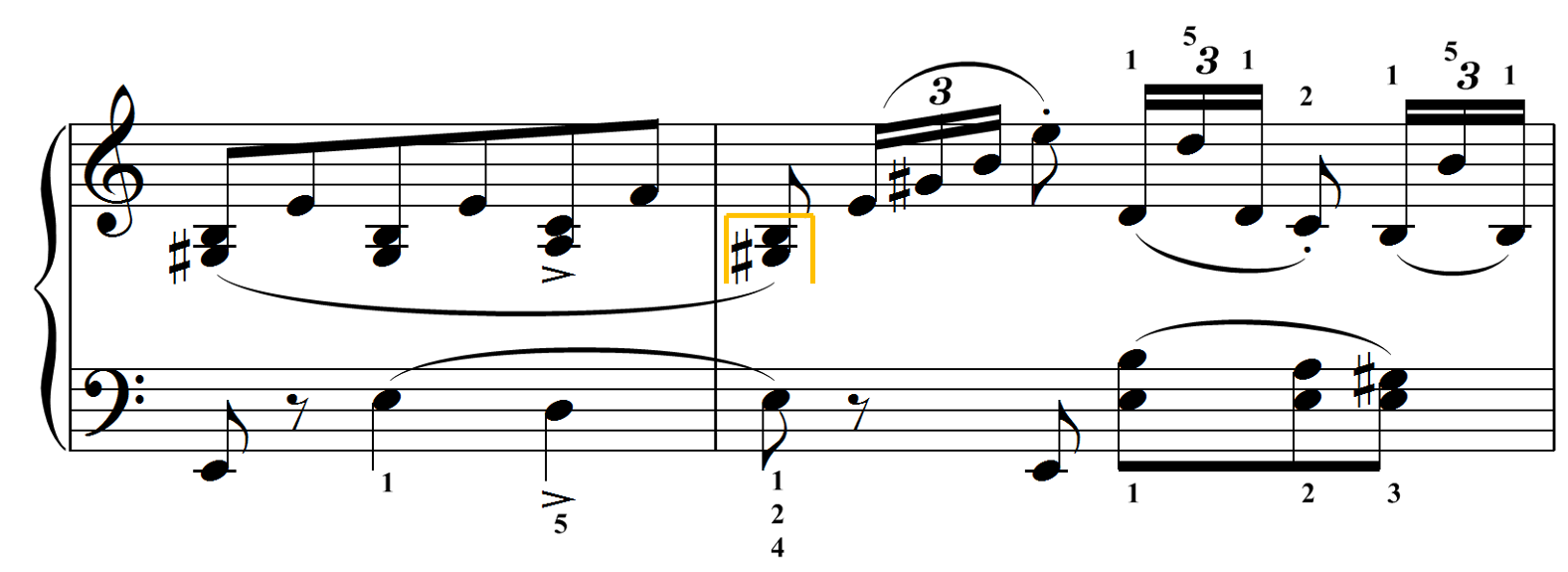“If the left hand notes are out of reach, they can be taken into the right hand.”
Submitted by Michael Clark
Published on 3/17/2020

“If the left hand notes are out of reach, they can be taken into the right hand.”
Submitted by Michael Clark
Published on 3/17/2020

“I’m more accurate when I let the left hand help with these quick shifts.”
Submitted by Michael Clark
Published on 3/22/2020

“The left hand is much closer to the E-flat than the right hand. I think an extra shift in the right hand is unnecessary.”
Submitted by Michael Clark
Published on 3/22/2020

“Reaching the C in the right hand is a nearly impossible stretch, but it fits into the left hand easily.”
Submitted by Michael Clark
Published on 3/22/2020

“Taking the Gs in the left hand in m. 28 allows the right hand to get into its next position early. Similarly, taking the C in the left hand in m. 30 makes the leap easier.”
Submitted by Michael Clark
Published on 3/26/2020

“I find taking a few of these notes in the right hand makes the left hand less awkward.”
Submitted by Michael Clark
Published on 3/26/2020

“Taking the B in the left hand prevents either an awkward stretch between 4 and 5 or a quick leap.”
Submitted by Michael Clark
Published on 3/26/2020

“Taking the Bs in the left hand in m. 19 helps reduce the number of wide positions in the right hand. Taking the C in m. 22 in the left hand gives the right hand extra time for its leap.”
Submitted by Michael Clark
Published on 3/26/2020

“Having released the lowest C, the left hand is now free to play the C of the alto line, freeing the right hand to shift positions.”
Submitted by Michael Clark
Published on 3/26/2020

“Taking this C as an octave in the left hand gives the right hand extra time for its leap.”
Submitted by Michael Clark
Published on 3/26/2020

“Presumably this is was Ravel’s intended distribution, but it took me a while to figure that out as an undergraduate collaborative pianist. Hopefully seeing this will save someone some headaches!”
Submitted by Michael Clark
Published on 4/13/2020

“At the rapid tempo of this song, I can do without this particular hand crossing. This fingering also reduces position shifts in the right hand and uncrosses the distribution of the inner notes .”
Submitted by Michael Clark
Published on 4/13/2020

“I prefer these E-flats in the right hand so that I can prepare better for the position of the following measure.”
Submitted by Michael Clark
Published on 4/13/2020

“Taking these two notes in the left hand allows the right hand just enough time to prepare for the grace notes.”
Submitted by Michael Clark
Published on 4/13/2020

“Taking the chord in the left hand gives the right hand time to move to its new position.”
Submitted by Michael Clark
Published on 4/13/2020
“This fingering helps prioritize the smooth line without an over-reliance on pedal that might muddy the texture and overcast the great counterpoint in the inner voices.”
Submitted by Wade Troyer
Published on 9/27/2022


“This fingering helps prioritize the smooth line without an over-reliance on pedal that might muddy the texture and overcast the great counterpoint in the inner voices.”
Submitted by Wade Troyer
Published on 9/27/2022

“I like to divide the groups of seven in a consistent pattern.”
Submitted by Michael Clark
Published on 4/13/2020